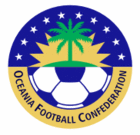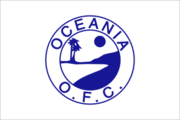Oceania Football Confederation
Football World Cup 2006 Germany
Oceania Football Confederation
Australia
 Oceania Football Confederation logo since 1998
Oceania Football Confederation logo since 1998
 Original Oceania Football Confederation logo
Original Oceania Football Confederation logo
The Oceania Football Confederation is one of the six "continental"
confederations of international
football. It promotes the game in Oceania and allows the member nations to qualify for the
Football World Cup.
The confederation was formed in 1966. The founding members were the
Australian Soccer Federation (now
Football Federation Australia), New Zealand Soccer Inc, and the Fiji
Football Association. On May 24, 2004, New Caledonia became the 12th member of the OFC.
In 1996 the OFC was confirmed as a full confederation and given a seat on
the FIFA
executive. The winner of the
OFC Football World Cup Qualifiers would be allowed to compete in a
two-legged home-and-away playoff with the team ranked fifth in the
South American qualifying competition for a place in the 2006 World Cup.
Since 1996, OFC members also play for the
OFC Nations Cup, which is held every second year.
The OFC also organises the Oceania Club Championship, though this
competition has little prestige attached to it and serves primarily to
determine the Oceania representitive at the FIFA Club World Championship.
In 1998, the OFC unveiled a new logo and an official magazine, entitled
The Wave.
Despite occasional "giant-killing" performances by New Zealand against
Australian sides without their full complement of overseas-based
professionals, only the
Australian national side, commonly called "the Socceroos", is regarded
as a potential force in world football.
In the
2004 OFC Nations Cup, which doubled as the Oceania qualifying tournament
for the
2006 World Cup, the
Solomon Islands unexpectedly made the finals against Australia, knocking out
New Zealand in the second group phase. Australia easily won the local
competition, beating the Solomons 5:1 in Honiara and 6:0 in Sydney. The two
teams met again in a two-legged World Cup qualifying final in September 2005
for the right to play the CONMEBOL representative for a place in the World
Cup final; Australia won 9:1 on aggregate (7:0 at home and 2:1 away) and
progressed to the
Oceania - South America playoff. Australia won this playoff against
Uruguay on penalties after a 1:1 aggregate score after both legs of the
playoff and after extra time, and qualified for the World Cup.
Oceania has sent representatives to the World Cup three times: Australia
in 1974 and 2006, and New Zealand in 1982. Neither Australia in 1974 nor New
Zealand in 1982 progressed beyond the first round.
On January 1, 2006, Australia left the OFC and joined the
Asian Football Confederation.
World Cup Qualifiers
OFC is the only FIFA confederation that does not have a guaranteed spot
in the World Cup finals. Between 1966 and 1982, OFC teams joined the Asian
zone qualification tournament, while from 1986 onwards, the winners of the
Oceanian zone qualification tournament have to enter the Intercontinental
Play-offs against teams from other confederations in order to gain a spot in
the World Cup finals.
| World Cup |
Qualifier(s) |
Notes |
|
1930-1962 |
None |
No teams from Oceania entered. |
|
1966 |
None |
|
|
1970 |
None |
|
|
1974 |
Australia |
|
|
1978 |
None |
|
|
1982 |
New Zealand |
|
|
1986 |
None |
Australia lost to
Scotland in the Intercontinental Play-offs. |
|
1990 |
None |
Israel (who played in the Oceanian zone due to political
reasons) lost to
Colombia in the Intercontinental Play-offs. |
|
1994 |
None |
Australia beat
Canada, then lost to
Argentina in the Intercontinental Play-offs. |
|
1998 |
None |
Australia lost to
Iran in the Intercontinental Play-offs. |
|
2002 |
None |
Australia lost to
Uruguay in the Intercontinental Play-offs. |
|
2006 |
Australia |
Australia beat Uruguay in the
Intercontinental Play-offs. |
- Total World Cup Finals appearances
External links
Home | Up | Confederation of African Football | Asian Football Confederation | Oceania Football Confederation | CONMEBOL | UEFA | CONCACAF
Football World Cup 2006, made by MultiMedia | Free content and software
This guide is licensed under the GNU
Free Documentation License. It uses material from the Wikipedia.
|




